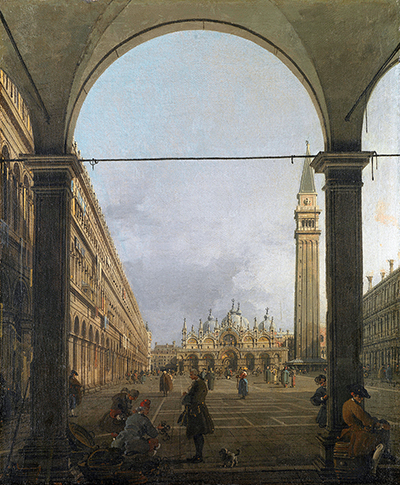The painting is part of six views of San Marco Plaza and Piazzetta in Venice in the centre of Venice. The sequence was probably the first commission of Canaletto by the British Venetian Consul, Joseph Smith, which sold his works to George III in 1762.
The collection is of the same proportions and possibly was meant to be symmetrically incorporated into the decoration of a single Venetian room, based on compositions and the specific handling of paint. Four of them are vertical, this painting and its pendant are horizontal, while the pendant is opposite of morning light at night. With each vision (also in the Royal Collection), a similarly associated preparatory sketch may have formed the basis of the artist- discussions. The analysis indicates that the quality and impact of the whole is important to them both in terms of the structure of the architecture. This tableau is significantly different from the original drawing (RCIN 907434). There are significant changes in the painting process, which means that it was the first of the series with its pair, and Canaletto later revised it.
In reference to the drawing, the point of view of San Marco was nearer to allow for the inclusion of the "Campanile" and the "Logetta" at the left, which cast a dramatic shadow on a painting which contrasted with sunshine areas. When building a precisely defined architecture space in the most elegant colours, inspired by the dense, flowing brushwork and sparkling touches of colour in the figures, can be seen through Canaletto's development as a painter of theatrical scenery. To the far left section is looming with the Procuratie Nuove seen between the Campanile and the Sansovino Logetta. In the centre of the frame, facing S. Marco church is S. Geminiano, which perfectly captured in the sunlight of the white stone façade in Istria. The S campanile is behind the roof-tops on the left, Moisè, and S. on the top, Stefano.
A temporary stage is placed on stimuli for a show in the right corner of the painting. The pole set on the first floor is possible for the installation of tents or booths. Canaletto paintings seem to be unframed when they went to London. They probably were set up in a space at one of the homes of Smith somewhere in Italy. The English 'Maratta' George III assembled and framed to hang them at the Buckingham House Entrance Hall. Once Horace Walpole saw them, he described them as "bolder, firmer, and much superior to the typical works of his [Canaletto]."




